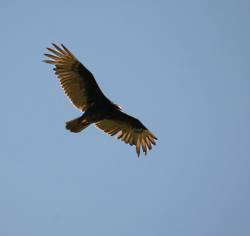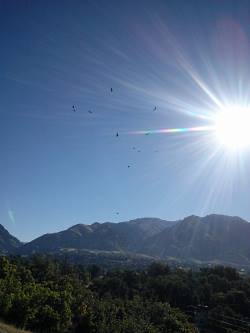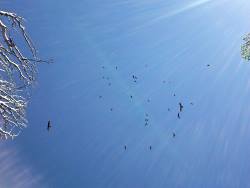
Cathartes aura
Courtesy Utah Division of Wildlife Resources
Scott Root, Photographer
Licensed under CCL
 Turkey Vulture Kettle above Logan
Turkey Vulture Kettle above Logan
Cathartes aura
Courtesy and Copyright
Andrea Liberatore, Photographer
 Turkey Vulture Kettle above Logan
Turkey Vulture Kettle above Logan
Cathartes aura
Courtesy and Copyright
Andrea Liberatore, Photographer
On certain days in the spring and fall, the sky above my neighborhood looks like a scene from Alfred Hitchcock’s ‘The Birds’. As many as 60 large black birds swarm the sky, circling above the rooftops. On the busiest of days, people will stop their cars in the middle of the road to gawk at the sight. Some give a visible shiver when told that the birds are turkey vultures. But we have nothing to fear from these birds – in fact they should be embraced for the absolutely vital role they play in our environment.
There are lots of myths surrounding vultures, which in turn creates a misunderstanding about them. So let’s set the record straight on a few things. Vultures circle for two main reasons, neither of which involves waiting for a sick or wounded animal to die. The first reason is to take advantage of rising columns of air, called thermals, which generally occur in the mornings as the sun warms the air closest to the earth. Vultures are soaring birds and flapping their 6-foot wingspans takes a lot of effort, so they rarely do it. In fact these birds can fly for hours without a single flap. Circling within a thermal helps them travel higher and farther on much less energy.
The second reason vultures circle is to hone in on a food source. Turkey vultures are one of the few birds that have a highly developed sense of smell. Working together with their excellent eyesight, the birds soar and circle to pin down the location of their next meal.
As most people know, vultures are scavengers – feasting on just about any dead animal. This means they almost never attack living prey. They prefer freshly dead animals, but generally take what they can get. Their stomachs are many times more acidic than ours, which helps them digest rotting meat without contracting food poisoning or other potentially deadly diseases. In areas where turkey vulture populations are healthy, dead animals are found and consumed quickly, halting the spread of disease and keeping us from being up to our kneecaps in carrion.
While vultures in the Americas resemble their European, Asian & African counterparts in both looks and behavior – both groups sport bare heads and specialize in eating carrion – they are actually not closely related. This is a great example of convergent evolution, where unrelated species independently evolve similar traits because of a shared ecological niche. A vulture’s head is bare to keep it clean while feeding inside a carcass. There is also recent evidence that suggests the bare skin plays a role in thermoregulation of these large birds’ bodies.
As fall progresses, vultures will migrate, leaving Utah for the winter. So this is a great time of year to keep an eye out for these incredible scavengers. When aloft, they are fairly easily identified by their soaring flight and the long ‘fingers’ at their wingtips. Turkey vultures are dark brown to black in color with silvery flight feathers visible on the hind half of their outspread wings. When soaring, they hold their wings in a slight dihedral, meaning they look like a shallow ‘v’, and they are known to teeter back and forth with the wind in what looks like a very unsteady manner.
So fear not those dark shapes circling in the sky above. Instead, gaze up in awe at a bird impeccably designed to do some of our world’s dirty work. And as you go about your Halloween preparations, make sure not to mischaracterize these majestic and incredibly important birds. Let me leave you with one last piece of turkey vulture trivia. When flying in a flock, such as those who take advantage of the thermals above my neighborhood, a group of vultures is called a kettle. However, when feeding on a carcass together, the group is called a wake. How incredibly appropriate.
For more information and pictures of turkey vultures, visit our website. For the Stokes Nature Center and Wild About Utah, this is Andrea Liberatore.
Credits:
Pictures: Courtesy Utah Division of Wildlife Resources, Scott Root Photographer, licensed under CCL
Pictures: Courtesy and Copyright Andrea Liberatore, Photographer
Text: Andrea Liberatore, Stokes Nature Center
Additional Reading:
International Vulture Awareness Day. Accessible online at: https://www.vultureday.org/2013/index.php
Alderfer, Jonathan, Ed. (2005) National Geographic: Complete Birds of North America. National Geographic International Publishing https://www.amazon.com/National-Geographic-Complete-Birds-America/dp/0792241754
The Peregrine Fund: Turkey Vulture. Available online at https://peregrinefund.org/explore-raptors-species/Turkey_Vulture
Nuthin’ But Turkey Vultures, NeoVista Birding, Jeff Cooper, https://www.neovistabirding.blogspot.com/2013/10/nuthin-but-turkey-vultures.html
